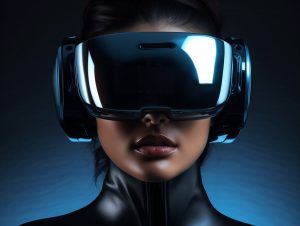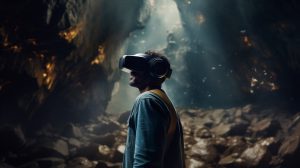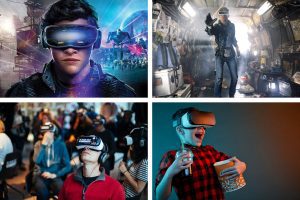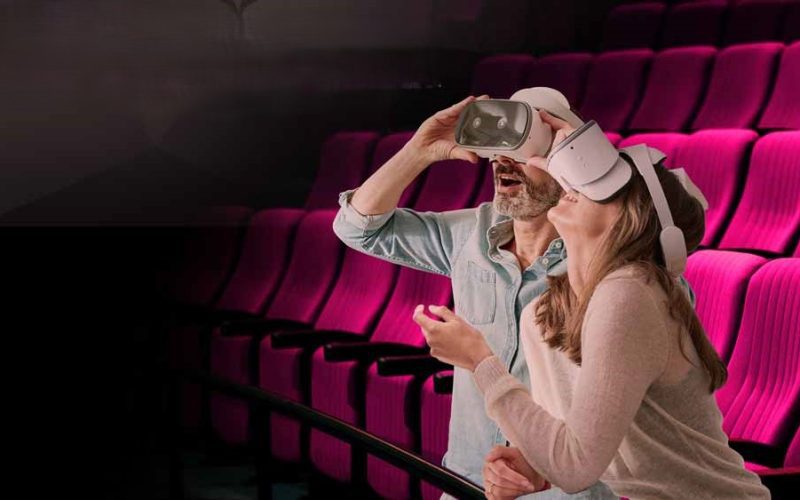Introduction
The integration of Augmented Reality (AR) and Virtual Reality (VR) technologies into cinema has transformed how stories are told and experienced. These immersive technologies enhance viewer engagement, creating unique narratives that blur the lines between reality and fiction. This article explores the profound impact of AR and VR on the film industry, examining their applications, benefits, challenges, and future prospects.
Understanding AR and VR

1. What is augmented reality (AR)?
Augmented reality (AR) overlays digital content onto the real world, allowing viewers to interact with both virtual and physical environments simultaneously. Through devices like smartphones or AR glasses, audiences can experience additional layers of information or visuals related to what they see in their immediate surroundings.
2. What is Virtual Reality (VR)?
Virtual Reality (VR), on the other hand, immerses users in a completely digital environment. By wearing VR headsets, viewers are transported to a simulated world where they can explore, interact, and engage with the narrative in a way that feels incredibly real. This technology requires specialized hardware to create a fully immersive experience.
Rise of AR and VR in Cinema

Augmented Reality (AR) and Virtual Reality (VR) have become more popular in cinema over the past few years. These technologies are changing how movies are made and experienced. With AR, filmmakers can add digital elements to the real world, while VR takes viewers into fully immersive environments. As audiences look for new and exciting experiences, the rise of AR and VR is helping to meet that demand and keep cinema relevant in a digital age.
Benefits of AR and VR in Cinema
AR and VR offer many benefits to filmmakers and viewers. These technologies enhance storytelling by allowing audiences to interact with characters and settings in new ways. With AR, viewers can see special effects and animations that blend with the real world. VR gives viewers a chance to step inside a movie and feel like they are part of the action. Both technologies create a more engaging and memorable experience, helping films stand out in a crowded market.
The Role of AR and VR in Cinema

Augmented Reality (AR) and Virtual Reality (VR) play an important role in shaping modern cinema. They change how movies are made and how viewers experience them. With AR, filmmakers can add digital images and sounds to the real world, making the movie experience more exciting. VR takes this a step further by immersing viewers in a completely different world, allowing them to feel like they are part of the story. This interaction creates a stronger connection between the audience and the film. As technology improves, the role of AR and VR will likely expand, offering even more creative ways to tell stories and engage audiences.
The Transformation of Cinema

1. Enhanced Storytelling
AR and VR offer filmmakers innovative ways to tell stories. Traditional cinema often relies on passive viewing, where audiences watch a film unfold on screen. With AR and VR, viewers become active participants. They can explore different perspectives, influencing how they perceive the narrative. This level of engagement can lead to a deeper emotional connection with the story.
2. Innovative Visual Effects
The use of AR and VR has also revolutionized visual effects in cinema. Filmmakers can create breathtaking scenes that were previously unimaginable. For instance, through VR, audiences can witness epic battles or fantastical worlds up close, making the experience more thrilling and memorable. This shift in visual storytelling allows for a greater sense of scale and wonder.
3. New Genres and Formats
The emergence of AR and VR has given rise to new genres and formats in cinema. Interactive films allow viewers to make choices that affect the storyline, resulting in multiple endings. This innovation not only enhances replayability but also invites viewers to engage with the material in a way that traditional films cannot.
The Current Applications of AR and VR in Cinema

1. Enhancing Viewer Engagement
AR and VR can significantly boost viewer engagement. For instance, films such as “Star Wars: The Force Awakens” have used AR to create interactive trailers that let viewers explore scenes through their devices. This interactive style keeps audiences interested and encourages them to share their experiences on social media, helping the movie reach a wider audience.
2. Immersive Storytelling
VR offers filmmakers a new way to tell stories by placing viewers directly in the action. Movies like “Dune” use VR to create experiences where audiences can explore and interact with the film’s world. This engagement helps viewers feel more connected to the characters and plot, creating a more memorable experience.
3. Marketing and Promotion
AR is also making waves in movie marketing. For example, promotional posters for “Spider-Man: Far From Home” included AR features that brought characters to life when scanned with a smartphone. This creative approach captures the audience’s attention and generates excitement about the film, encouraging more people to go see it in theaters.
Challenges of Integrating AR and VR

1. Technical Limitations
Despite their potential, AR and VR technologies face several challenges. High production costs and the need for specialized equipment can be barriers for filmmakers. Additionally, creating high-quality content that takes full advantage of these technologies requires significant skill and resources.
2. Audience Accessibility
Not all audiences have access to the technology needed to experience AR and VR. While smartphones can facilitate AR experiences, VR typically requires more advanced equipment, which can limit the audience base. This accessibility issue may hinder widespread adoption of these immersive formats in mainstream cinema.
Educational Opportunities in Filmmaking

AR and VR can also play an important role in film education. Film schools are starting to incorporate these technologies into their curricula. Students can learn how to create AR and VR content, which can set them apart in a competitive industry. By understanding these tools, aspiring filmmakers can develop new skills that will help them tell stories in innovative ways.
The Impact on Viewer Emotions

AR and VR have the power to evoke strong emotions in viewers. By immersing audiences in a story, filmmakers can create deeper emotional connections with their characters and plots. For example, VR experiences can put viewers in dramatic situations, making them feel the tension and excitement as if they were part of the story. This ability to engage emotions can lead to a more powerful and lasting impact on the audience.
The Future of Cinema with AR and VR

1. Expanding Horizons
As AR and VR technologies continue to evolve, their influence on cinema is likely to expand. Innovations in hardware, such as lighter and more affordable VR headsets, will make these experiences more accessible to the general public. Filmmakers will likely explore even more creative ways to integrate these technologies into storytelling.
2. Collaborative Experiences
Future cinema experiences may also focus on collaboration. AR and VR can facilitate social viewing, where multiple users interact in a shared virtual environment. This shift could transform how audiences experience films, making them more communal and engaging.
Comparative Analysis: AR vs. VR in Cinema
| Aspect | Augmented Reality (AR) | Virtual Reality (VR) |
|---|---|---|
| User Experience | Enhances the real-world experience with overlays | Immerses users in a completely virtual environment |
| Accessibility | More accessible via smartphones and tablets | Requires specialized VR headsets |
| Interactivity | Limited interaction with the real world | High level of interaction with the virtual world |
| Production Costs | Generally lower production costs | Higher production costs due to advanced technology |
| Target Audience | Broad audience; can be used in various settings | Niche audience; requires investment in VR gear |
Conclusion
The integration of AR and VR in cinema represents a significant shift in how stories are told and experienced. These technologies enhance viewer engagement, offer innovative storytelling formats, and create stunning visual effects. However, challenges such as technical limitations and accessibility issues remain. As AR and VR technologies continue to develop, their impact on cinema will likely grow, leading to exciting new possibilities for filmmakers and audiences alike.












